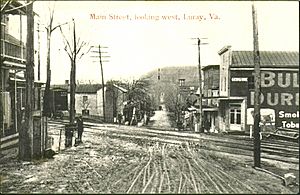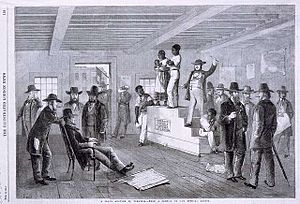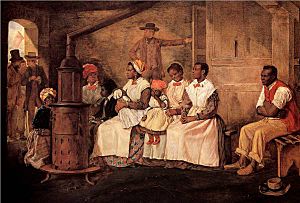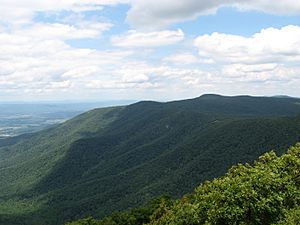Bethany Veney facts for kids
Quick facts for kids
Bethany Veney
|
|
|---|---|
 |
|
| Born |
Bethany Johnson
c. 1812–1815 near Luray, Virginia in what is now Page County, Virginia
|
| Died | November 16, 1915 |
| Other names | "Aunt Betty", Betsy, "Aunt Betsy" |
| Known for | Aunt Betty's Story: The Narrative of Bethany Veney, A Slave Woman (1889) |
| Spouse(s) |
|
| Children |
|
| Parent(s) | Joseph and Charlotte Johnson |
Bethany Veney (born around 1812–1815 – died November 16, 1915) was an American woman who was born into slavery. Her birth name was Bethany Johnson. She wrote a book about her life called Aunt Betty's Story: The Narrative of Bethany Veney, A Slave Woman. This book was published in 1889.
Bethany was married two times. Her first husband, Jerry Fickland, was also enslaved. They had a daughter named Charlotte. Jerry was later sold away from Bethany. She then married Frank Veney, who was a free Black man. Bethany herself was later sold to George J. Adams. He took her to Providence, Rhode Island, and then to Worcester, Massachusetts. After the American Civil War, Bethany Veney made four trips back to Virginia. She wanted to bring her daughter, her daughter's family, and 16 other relatives to live in New England.
Contents
Bethany Veney's Early Life

Bethany Johnson was born into slavery around 1815. She was born on a farm called Pass Run, near Luray, Virginia. This area is now known as Page County, Virginia. Her parents, Charlotte and Joseph Johnson, had five children. Bethany was part African American and part Blackfoot.
She was owned by James Fletcher. Fletcher's daughter, Nasenith, taught Bethany a lesson about lying. Her mother also taught her about being truthful. This lesson about honesty helped Bethany throughout her life. Sometimes, Fletcher asked Bethany to sing and dance for his guests.
Bethany's mother died when Bethany was about nine years old. She did not know her father. Soon after her mother's death, James Fletcher also died. The enslaved people he owned were divided among his children. This meant Bethany's family was split up. Bethany and her sister Matilda were given to Lucy Fletcher. Lucy was unmarried and moved in with her sister Nasenith and David Kibbler after they married in 1827.
For a while, Bethany was "hired out" to another woman. This meant she worked for the woman in exchange for food and clothes. Bethany thought this woman was kind because she was fed enough and not whipped. However, Bethany knew that white children who were not enslaved would have a different idea of kindness.
David Kibler, her owner, was very cruel to all the enslaved people in his home. Once, he whipped her so badly that she became lame. When her mistress asked about her injury, Kibbler whipped Bethany again. Another time, she was told to get a stick for a beating. Instead, she ran away. After a rainy night, she found help from Kibbler's father. He was also a slave owner. After hearing her story, he told his son not to whip her. Bethany returned and was not beaten.
Bethany's Faith and Religion
Kibbler's brother Jerry and sister Sally became Methodists. They found their faith after going to a camp meeting. They turned a schoolhouse in Luray into a church and encouraged Bethany to become a Christian. Lucy arranged for Bethany to go to a camp meeting. There, a hymn deeply inspired her.
Then let this feeble body fail,
Or let it faint or die,
My soul shall quit this mournful vale,
And soar to worlds on high,
Shall join those distant saints,
And find its long-sought rest.
Bethany began to pray for her freedom. She believed that if she was a good Christian, her dream would come true. She often imagined earning her own money and saving it to buy a house with a beautiful garden. Her faith helped her through many hard times in her life.
Even as a young girl, her owner punished her severely for going to church. But she kept going when she was hired out to Mr. Levers. She also begged Kibbler to let her attend church. He finally agreed, saying, "Well, I'll go the devil if you ain't my match. Yes, go to meeting..." From then on, she could go to church. She became known for being honest and devoted to her faith.
Marriage and Family Life
Around the late 1830s, Bethany Johnson married Jerry Fickland. He was an enslaved man who lived seven miles away. Their owners gave them permission to marry. They had a simple wedding. They knew they could be separated at any time. So, they did not promise to be true or forsake all others.
They continued to live on their owners' farms. They could only visit each other when they had permission and a pass to travel. Without a pass, they could be caught as runaways.
Jerry Fickland was owned by Jonas Mannyfield, who was in debt. Around March 1843, Jerry was taken to a slave pen in Little Washington, Virginia, to be sold. Bethany got permission to see her husband. She traveled for more than a day to meet Jerry's mother. They went together to the slave pen.
A slave trader named Frank White bought the enslaved people. He planned to sell them in the Deep South. White sent Jerry to get Bethany, promising they would stay together. But Jerry knew they would likely be separated. He also knew they would suffer in the harsh cotton fields and rice swamps further south. So, Jerry ran away to the mountains. He was caught by another slave trader, David McCoy. Bethany never saw Jerry again.
Their daughter, Charlotte E. Fickland, was born in January 1844. She was named after Bethany's mother.
Bethany asked to be sold to John Printz Sr. of Luray, and she and her daughter were. She worked for his family until the early 1850s. Then, she was sold to McCoy and his partner John O'Neile. Her daughter stayed with the Printz family.
When Bethany realized she was about to be sold, she asked a white person from her church to buy her. But they said no. She was taken to a slave auction in Richmond, Virginia. Before the bidding started, she pretended to be sick by putting baking soda in her mouth. She foamed at the mouth, and no one bought her.
Bethany then worked in the McCoy household. She was also "hired out" to others. She paid McCoy $20 a year and kept the rest of her earnings. She was able to visit her daughter sometimes.
Later, she married a free Black man named Frank Veney. She then became Bethany Veney. Frank built roads for McCoy. Bethany met Frank when she was a cook for the road construction crew. They had a son named Joe.
Life at Stony Man Mountain
Bethany made a deal with David McCoy and John Printz. She was allowed to rent a house from Printz on Stony Man. This was a mountain area south of Luray. She supported herself and her son by working and earning wages. She paid McCoy $30 each year from her earnings.
In the late 1850s, Bethany was hired as a cook and housekeeper. She earned $1.50 per week. She worked for copper mining investors, George J. Adams and J. Butterworth. They were from Providence, Rhode Island. They had reopened a mine near Stony Man Mountain.
McCoy's property was taken and sold because of his gambling debts. On December 27, 1858, George J. Adams bought Bethany and her son Joe for $775 (which is about $28,000 today).
Freedom in New England
Adams moved Bethany and her son to Providence, Rhode Island, in August 1859. There, both of them were freed by Adams. Bethany supported herself by doing laundry and selling bluing (a laundry product) door-to-door. Sadly, her son Joe died from an illness later that year.
Living in New England, Bethany was separated from her daughter, son-in-law, and husband. Her husband, Frank Veney, married another woman after three years. It was too dangerous for a Black woman to travel alone to Virginia to visit her family. This was especially true after John Brown's raid on Harpers Ferry (October 1859) and the start of the American Civil War (1861–1865).
Bethany worked for the Adams family in Providence. Then, she moved with them to Worcester, Massachusetts, in 1860. Before the Civil War, she made large pots of gruel (a thin porridge) for the camps of the Worcester Volunteers. She continued to sell bluing and do laundry in Massachusetts.
She felt safe in Worcester, knowing she would not be sold again. So, she stayed there after the Adams family returned to Providence. Bethany joined the Park Street Methodist Church, which was a white church. She also helped start the African Methodist Episcopal Bethel Church in 1867. She was an important member of that church. For over 50 years, she walked to the Sterling Camp Meeting Grounds in Sterling, Massachusetts. This was a nearly 12-mile walk, taking about 4 hours one way.
After the Civil War ended, Bethany Veney worked to bring her family members to New England. She started with her daughter, son-in-law Aaron Jackson, and grandchild. They lived next to her. Then, she made three more trips to move 16 more relatives north. While in the Luray, Virginia area, she also met three of her former owners: McCoy, Printz, and Kibbler. She was thankful to be free from the suffering she had endured for years. She was also happy to be reunited with her family. In Worcester, she bought a house for herself at 21 Winfield Street. She also bought other houses for her extended family.
Narrative of Bethany Veney, a Slave Woman
In 1889, Bethany Veney's book, Narrative of Bethany Veney, a Slave Woman, was published. A white woman with the initials M. W. G. wrote down Bethany's story as Bethany told it. The book tells about her life as an enslaved child and woman. It also describes her religious conversion and how faith helped her.
Her book includes letters from two ministers, Rev. Erastus Spaulding and Rev. V.A. Cooper. One letter talks about Bethany's strong character. The other focuses on how wrong slavery was. Bethany also describes her life in the North after she became free.
Jared Silverstein, an author, said that Bethany's "short yet powerful narrative reveals how her unremitting faith in God empowered her to navigate the most trying of circumstances, from childhood as a slave to adulthood as a woman fighting for her freedom." Bethany had a special way of telling her story. She focused on her human experiences, her heartaches, and the morals she lived by. She did not just list all the terrible things about slavery.
Later Years and Death
Bethany Veney stayed active throughout her long life. She died at her daughter's house in Worcester on November 16, 1915. She was buried at Hope Cemetery in the same city. Her daughter Charlotte, who died in 1921, is buried next to her.
Bethany Veney's Legacy
On July 12, 2003, the Governor of Massachusetts, Mitt Romney, signed a special paper. It honored Bethany Veney and her life. He declared that day "Bethany Veney Day in Worcester, Massachusetts."
Anthony Gerard, in his book Collected Black Women's Narratives, recognized Bethany Veney. He said she, along with others like Susie King Taylor and Nancy Prince, "strove to maintain her dignity and independence." He also said her book shows "Veney's experiences in slavery and in freedom and her spiritual growth throughout her life." It also "revealed her defiance, ingenuity, fortitude, and independence. In the inhuman grip of chattel slavery, Veney continually demonstrates her humanity..."
Images for kids





